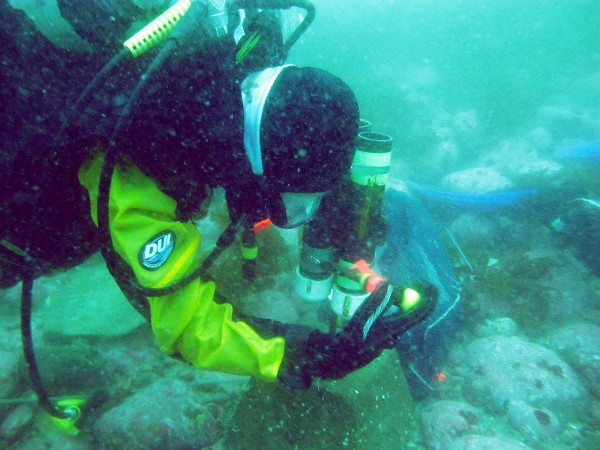Glacier silt hinders establishment of kelp beds
January 12, 2016
Lauren Frisch
907-474-5022

Long-term buildup of silt from glacier melt is limiting kelp bed growth in Alaska's Kachemak Bay, according to an ongoing study by University of Alaska Fairbanks researchers.
Kelp forests play an important role in coastal areas as a nursery for fish and invertebrates. They also protect shorelines from coastal erosion. People living near Kachemak Bay harvest kelp and the chitons and crabs that live in the large kelp beds.
Brenda Konar, a professor at the UAF School of Fisheries and Ocean Sciences, is working with doctoral student Sarah Traiger to study the effects of glacier melt on kelp reproductive cells' ability to travel, settle and grow in Kachemak Bay.
Kelp like to grow on rocks. When silt carried by glacier melt settles on the underwater rocks, kelp beds may be unable to take hold. Additionally, silt suspended in the water can block light from penetrating the bottom layers of the bay, making it difficult for kelp to photosynthesize.
The source of glacier melt in Kachemak Bay is the nearby Harding Icefield. The icefield has shrunk by 3 percent during the past 16 years, according to the National Park Service.
“As glaciers on the Harding Icefield continue to melt, we need to understand how communities and ecosystems are likely to change,” said Konar.
Konar and Traiger did their fieldwork during the summers of 2013 and 2014. They gathered samples at three sites in inner Kachemak Bay where substantial influence from glacier melt was expected, and at three sites in outer Kachemak Bay with little or no expected influence. The researchers placed flat rocks at each of the study sites. They measured the species that settled and grew on each rock and recorded temperature, salinity, light, nutrient concentrations and sediment rates.
Initially, grazing animals such as sea urchins played the greatest role in deterring kelp growth. But as sediment built up on the rocks, the cumulative effect of the sediment became the primary driver in preventing kelp from settling and growing on the rocks.
“This research gives us a baseline understanding of what we should monitor to determine what is changing and what is likely to change in the future,” Konar said. “It allows us to evaluate what might happen to populations downstream if glacier melt continues to increase over time.” The results will help managers and decisionmakers predict and prepare in advance for changes, Konar said.
The research is funded by Alaska Sea Grant, with additional support from the UAF Center for Global Change and the SFOS Robert Byrd competition.
NOTE TO EDITORS: A photo is available for download from //news.uaf.edu/glaciersilt
ON THE WEB: https://seagrant.uaf.edu/news/2016/01-12-16-kachemak-bay-glaciers-kelp.php
ADDITIONAL CONTACTS: Brenda Konar, 907-474-5028, bkonar@alaska.edu.


